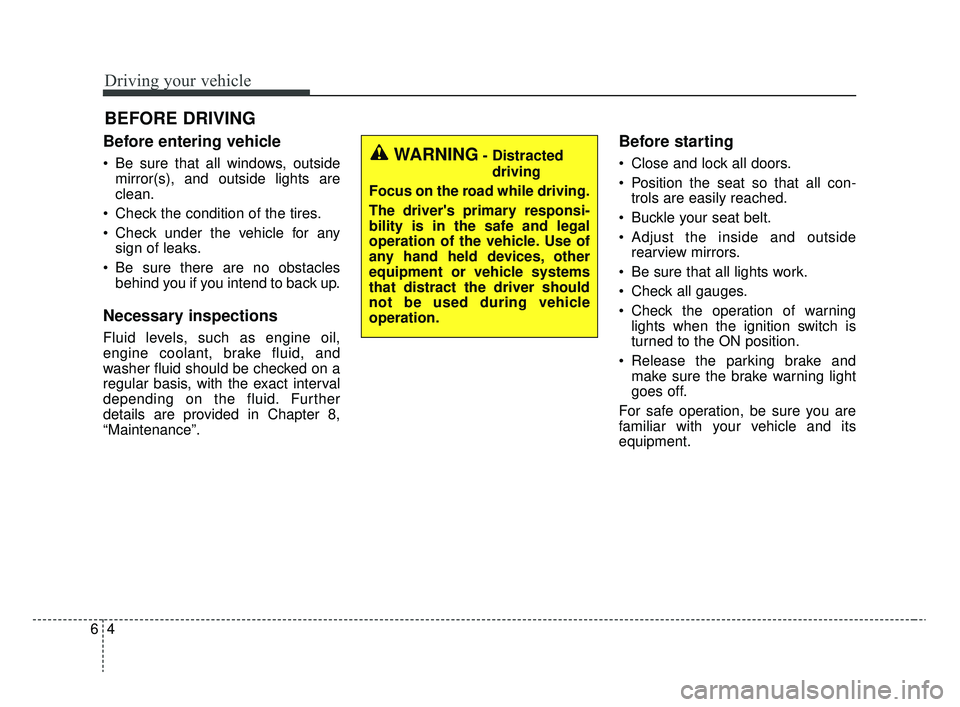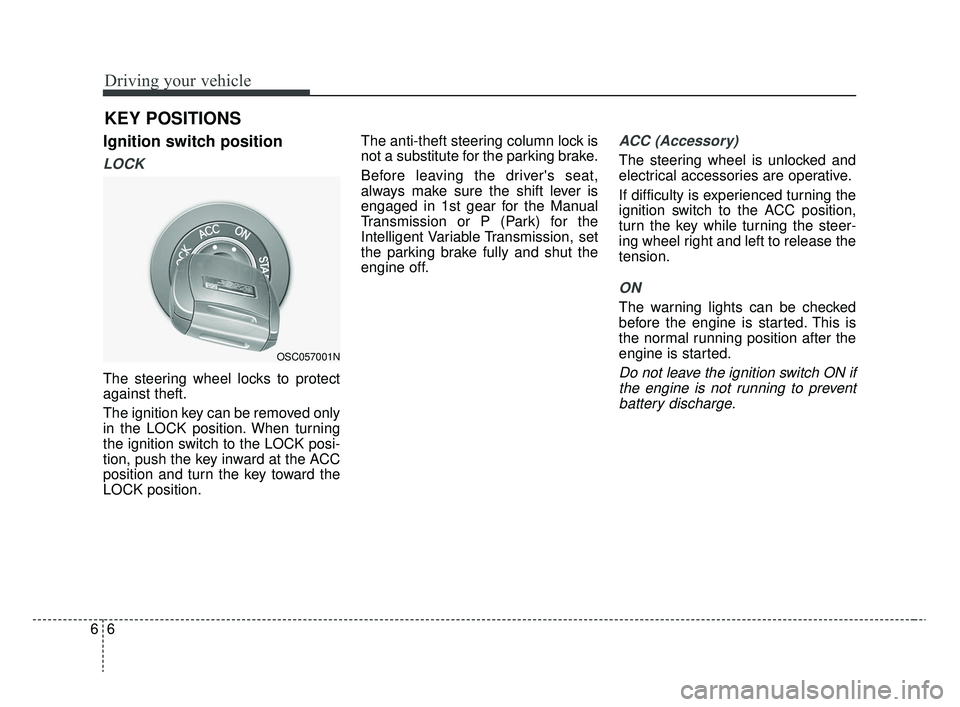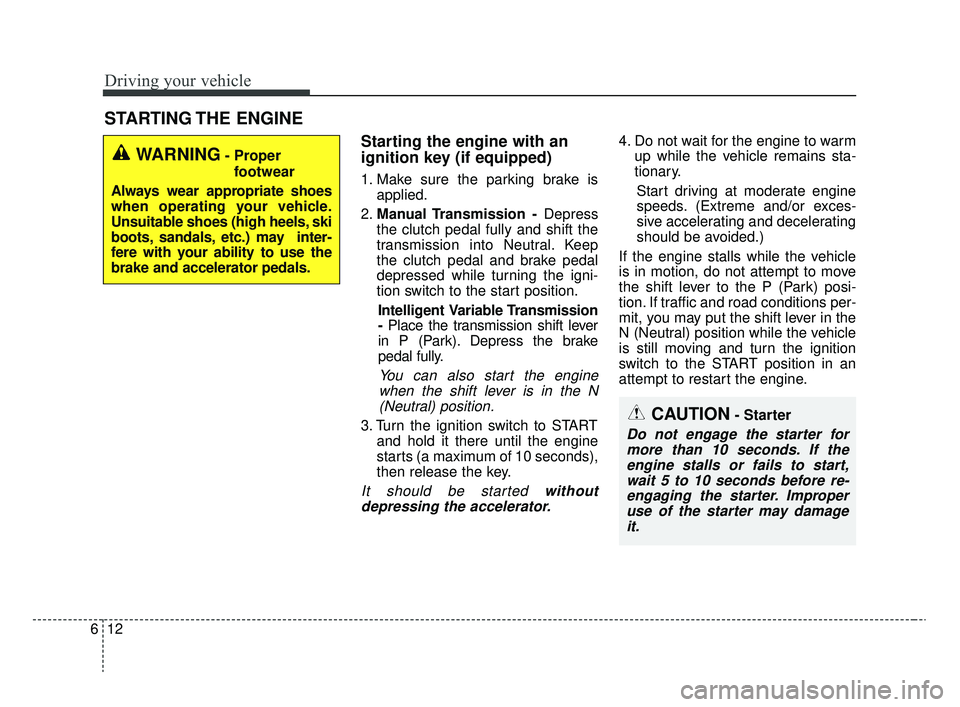2020 KIA RIO parking brake
[x] Cancel search: parking brakePage 269 of 516

6
Special driving conditions . . . . . . . . . . . . . . . . . . . 6-62
• Hazardous driving conditions . . . . . . . . . . . . . . . . . . 6-62
• Rocking the vehicle . . . . . . . . . . . . . . . . . . . . . . . . . . . 6-62
• Smooth cornering . . . . . . . . . . . . . . . . . . . . . . . . . . . . 6-63
• Driving at night . . . . . . . . . . . . . . . . . . . . . . . . . . . . . . 6-63
• Driving in the rain . . . . . . . . . . . . . . . . . . . . . . . . . . . . 6-64
• Driving in flooded areas . . . . . . . . . . . . . . . . . . . . . . . 6-65
• Driving off-road . . . . . . . . . . . . . . . . . . . . . . . . . . . . . . 6-65
• Highway driving . . . . . . . . . . . . . . . . . . . . . . . . . . . . . 6-65
Winter driving . . . . . . . . . . . . . . . . . . . . . . . . . . . . 6-67
• Snowy or Icy conditions . . . . . . . . . . . . . . . . . . . . . . . 6-67
• Use high quality ethylene glycol coolant . . . . . . . . . . 6-68
• Check battery and cables . . . . . . . . . . . . . . . . . . . . . . 6-68
• Change to "winter weight" oil if necessary . . . . . . . 6-68
• Check spark plugs and ignition system. . . . . . . . . . . 6-68
• To keep locks from freezing . . . . . . . . . . . . . . . . . . . . 6-68
• Use approved window washer anti-freeze in system . . . . . . . . . . . . . . . . . . . . . . . . . . . . . . . . . . . . \
. 6-68
• Don't let your parking brake freeze . . . . . . . . . . . . . 6-69
• Don't let ice and snow accumulate underneath . . . . 6-69
• Carry emergency equipment . . . . . . . . . . . . . . . . . . . 6-69
Vehicle load limit . . . . . . . . . . . . . . . . . . . . . . . . . . 6-70
• Tire and loading information label . . . . . . . . . . . . . . 6-70
• Certification label . . . . . . . . . . . . . . . . . . . . . . . . . . . . 6-73
Vehicle weight . . . . . . . . . . . . . . . . . . . . . . . . . . . . . 6-75
• Base curb weight . . . . . . . . . . . . . . . . . . . . . . . . . . . . . 6-75
• Vehicle curb weight . . . . . . . . . . . . . . . . . . . . . . . . . . . 6-75
• Cargo weight . . . . . . . . . . . . . . . . . . . . . . . . . . . . . . . . 6-75
• GAW (Gross Axle Weight) . . . . . . . . . . . . . . . . . . . . . 6-75
• GAWR (Gross Axle Weight Rating) . . . . . . . . . . . . . 6-75
• GVW (Gross Vehicle Weight) . . . . . . . . . . . . . . . . . . . 6-75
• GVWR (Gross Vehicle Weight Rating) . . . . . . . . . . . 6-75
SC CAN (ENG) 6.QXP 6/7/2019 9:49 AM Page 2
Page 271 of 516

Driving your vehicle
46
Before entering vehicle
• Be sure that all windows, outsidemirror(s), and outside lights are
clean.
Check the condition of the tires.
Check under the vehicle for any sign of leaks.
Be sure there are no obstacles behind you if you intend to back up.
Necessary inspections
Fluid levels, such as engine oil,
engine coolant, brake fluid, and
washer fluid should be checked on a
regular basis, with the exact interval
depending on the fluid. Further
details are provided in Chapter 8,
“Maintenance”.
Before starting
Close and lock all doors.
Position the seat so that all con-trols are easily reached.
Buckle your seat belt.
Adjust the inside and outside rearview mirrors.
Be sure that all lights work.
Check all gauges.
Check the operation of warning lights when the ignition switch is
turned to the ON position.
Release the parking brake and make sure the brake warning light
goes off.
For safe operation, be sure you are
familiar with your vehicle and its
equipment.
BEFORE DRIVING
WARNING- Distracted driving
Focus on the road while driving.
The driver's primary responsi-
bility is in the safe and legal
operation of the vehicle. Use of
any hand held devices, other
equipment or vehicle systems
that distract the driver should
not be used during vehicle
operation.
SC CAN (ENG) 6.QXP 6/7/2019 9:49 AM Page 4
Page 273 of 516

Driving your vehicle
66
Ignition switch position
LOCK
The steering wheel locks to protect
against theft.
The ignition key can be removed only
in the LOCK position. When turning
the ignition switch to the LOCK posi-
tion, push the key inward at the ACC
position and turn the key toward the
LOCK position.The anti-theft steering column lock is
not a substitute for the parking brake.
Before leaving the driver's seat,
always make sure the shift lever is
engaged in 1st gear for the Manual
Transmission or P (Park) for the
Intelligent Variable Transmission, set
the parking brake fully and shut the
engine off.
ACC (Accessory)
The steering wheel is unlocked and
electrical accessories are operative.
If difficulty is experienced turning the
ignition switch to the ACC position,
turn the key while turning the steer-
ing wheel right and left to release the
tension.
ON
The warning lights can be checked
before the engine is started. This is
the normal running position after the
engine is started.
Do not leave the ignition switch ON if
the engine is not running to preventbattery discharge.
KEY POSITIONS
OSC057001N
SC CAN (ENG) 6.QXP 6/7/2019 9:49 AM Page 6
Page 274 of 516

67
Driving your vehicle
START
Turn the ignition switch to the START
position to start the engine. The
engine will crank until you release
the key; then it returns to the ON
position. The brake warning light can
be checked in this position.
✽ ✽NOTICE
If you leave the ignition switch to the
ACC or ON position for a long time,
the battery may discharge.
WARNING- Ignition
switch
Never turn the ignition switch to
LOCK or ACC while the vehicle
is moving. This would result in
loss of directional control and
braking function, which could
cause an accident.
WARNING- Steering wheel
Never reach for any controls
through the steering wheel
while the vehicle is in motion.
The presence of your hand or
arm in this area could cause a
loss of vehicle control.
WARNING- Key holder
Do not attach small purses,
multiple keys, or any other
heavy accessories to the dri-
ver's key chain used to start the
vehicle. This may cause the
inserted key to inadvertently
change the ignition position to
the ACC position while the vehi-
cle is moving, thereby increas-
ing the risk of an accident and
deactivating several safety fea-
tures.
WARNING- Leaving the vehicle
To avoid unexpected or sudden
vehicle movement, never leave
your vehicle if the transmission
is not locked in the P (Park)
position and the parking brake
is not fully engaged. Before
leaving the driver's seat, always
make sure the shift lever is
engaged in P (Park), set the
parking brake fully and shut the
engine off.
SC CAN (ENG) 6.QXP 6/7/2019 9:49 AM Page 7
Page 279 of 516

Driving your vehicle
12
6
Starting the engine with an
ignition key (if equipped)
1. Make sure the parking brake is
applied.
2. Manual Transmission - Depress
the clutch pedal fully and shift the
transmission into Neutral. Keep
the clutch pedal and brake pedal
depressed while turning the igni-
tion switch to the start position.
Intelligent Variable Transmission
- Place the transmission shift lever
in P (Park). Depress the brake
pedal fully.
You can also start the engine when the shift lever is in the N(Neutral) position.
3. Turn the ignition switch to START and hold it there until the engine
starts (a maximum of 10 seconds),
then release the key.
It should be started withoutdepressing the accelerator.
4. Do not wait for the engine to warm up while the vehicle remains sta-
tionary.
Start driving at moderate engine
speeds. (Extreme and/or exces-
sive accelerating and decelerating
should be avoided.)
If the engine stalls while the vehicle
is in motion, do not attempt to move
the shift lever to the P (Park) posi-
tion. If traffic and road conditions per-
mit, you may put the shift lever in the
N (Neutral) position while the vehicle
is still moving and turn the ignition
switch to the START position in an
attempt to restart the engine.
STARTING THE ENGINE
WARNING- Proper footwear
Always wear appropriate shoes
when operating your vehicle.
Unsuitable shoes (high heels, ski
boots, sandals, etc.) may inter-
fere with your ability to use the
brake and accelerator pedals.
CAUTION- Starter
Do not engage the starter for more than 10 seconds. If theengine stalls or fails to start,wait 5 to 10 seconds before re-engaging the starter. Improperuse of the starter may damageit.
SC CAN (ENG) 6.QXP 6/7/2019 9:49 AM Page 12
Page 280 of 516

613
Driving your vehicle
Starting the engine with a
smart key (if equipped)
1. Carry the smart key or leave itinside the vehicle.
2. Make sure the parking brake is firmly applied.
3. Place the transmission shift lever in P (Park).
4. Press the ENGINE START/STOP button while depressing the brake
pedal.
5. In extremely cold weather (below 0°F / -18°C) or after the vehicle
has not been operated for several
days, let the engine warm up with-
out depressing the accelerator. Whether the engine is cold or warm,
it should be started without depress-
ing the accelerator.
Even if the smart key is in the vehi-
cle, but is far away from you, the
engine may not start.
When the ENGINE START/STOP button is in the ACC position or
above, if any door is opened, the
system checks for the smart key. If
the smart key is not in the vehi-
cle,the “ ” or “ ” indicator will
blink or the warning "Key not in
vehicle" will illuminate on the LCD
display. And if all doors are closed,
the chime will sound for 5 seconds.
The indicator or warning will turn
off while the vehicle is moving.
Always have the smart key with
you.
The engine will start only when the
smart key is in the vehicle.
KEY
OUT
WARNING- Unintended
vehicle movement
Never leave the smart key in the
vehicle with children or vehicle
occupants who are unfamiliar
with the vehicle operation.
Pushing the ENGINE START/
STOP button while the smart
key is in the vehicle may result
in unintended engine activation
and/or unintended vehicle
movement.
SC CAN (ENG) 6.QXP 6/7/2019 9:49 AM Page 13
Page 283 of 516

Driving your vehicle
16
6
During cold weather, shifting may
be difficult until the transmission
lubricant is warmed up. This is nor-
mal and not harmful to the trans-
mission.
If you've come to a complete stop and it's hard to shift into 1st or R
(Reverse), leave the shift lever at
the N (Neutral) position and
release the clutch. Depress the
clutch pedal and then shift into 1st
or R (Reverse) gear position.
CAUTION - Premature
wear
Do not use the shift lever as ahandrest during driving, as thiscan result in premature wear ofthe transmission shift forks.
CAUTION
To prevent possible damage to the clutch system, do notstart with the 2nd (second)gear engaged except whenyou start on a slippery road.
If the clutch pedal is released rapidly after shifting into 1stor R(Reverse), it could causethe engine to stall and lead toan accident.
The clutch pedal should be fully depressed. When thepedal is released, make surenot to depress the pedal againbefore it returns to the normalposition. Failure to do sorepeatedly may cause damageto the clutch system.
Do not overload the vehicle. Driving with the vehicle over-loaded could cause abnormalfriction heat to the clutch diskand damage the clutch coverand disk.
WARNING- Shift lever
position
Before leaving the driver’s seat, always set the parking
brake fully and shut the
engine off. Then make sure
the transmission is shifted
into 1st gear when the vehicle
is parked on a level or uphill
grade, and shifted into R
(Reverse) on a downhill
grade. Unexpected and sud-
den vehicle movement can
occur if these precautions are
not followed in the order iden-
tified.
Do not use the engine brake (shifting from a high gear to
lower gear) rapidly on slip-
pery roads. The vehicle may
slip, causing an accident.
SC CAN (ENG) 6.QXP 6/7/2019 9:49 AM Page 16
Page 284 of 516

617
Driving your vehicle
Using the clutch
The clutch should be depressed all
the way to the floor before shifting,
then released slowly. The clutch
pedal should always be fully
released while driving. Do not rest
your foot on the clutch pedal while
driving. This can cause unnecessary
wear. Do not partially engage the
clutch to hold the vehicle on an
incline. This causes unnecessary
wear. Use the foot brake or parking
brake to hold the vehicle on an
incline. Do not operate the clutch
pedal rapidly and repeatedly.
Downshifting
When you must slow down in heavy
traffic or while driving up steep hills,
downshift before the engine starts to
labor. Downshifting reduces the
chance of stalling and gives better
acceleration when you need to
increase your speed again. When the
vehicle is traveling down steep hills,
downshifting helps maintain safe
speed and prolongs brake life.
Good driving practices
Never take the vehicle out of gearand coast down a hill. This is
extremely hazardous. Always leave
the vehicle in gear.
Don't "ride" the brakes. This can cause them to overheat and mal-
function. Instead, when you are
driving down a long hill, shift to a
lower gear. When you do this,
engine braking will help slow down
the vehicle.
Slow down before shifting to a lower gear. This will help avoid
over-revving the engine, which can
cause damage.
Slow down when you encounter cross winds. This gives you much
better control of your vehicle.
Be sure the vehicle is completely stopped before you attempt to shift
into R (Reverse). The transmission
can be damaged if you do not.WARNING
Exercise extreme cautionwhen driving on a slippery
surface. Be especially careful
when braking, accelerating or
shifting gears. On a slippery
surface, an abrupt change in
vehicle speed can cause the
drive wheels to lose traction
and the vehicle to lose con-
trol.
Always buckle-up! In a colli- sion, an unbelted occupant is
significantly more likely to be
seriously injured or killed
than a properly belted occu-
pant.
Never exceed posted speed limits.
Avoid high speeds when cor- nering or turning. High speed
cornering and turning
increases the risk of vehicle
rollover due to loss of vehicle
control. Rollover accidents
are extremely violent and
unpredictable.
SC CAN (ENG) 6.QXP 6/7/2019 9:49 AM Page 17